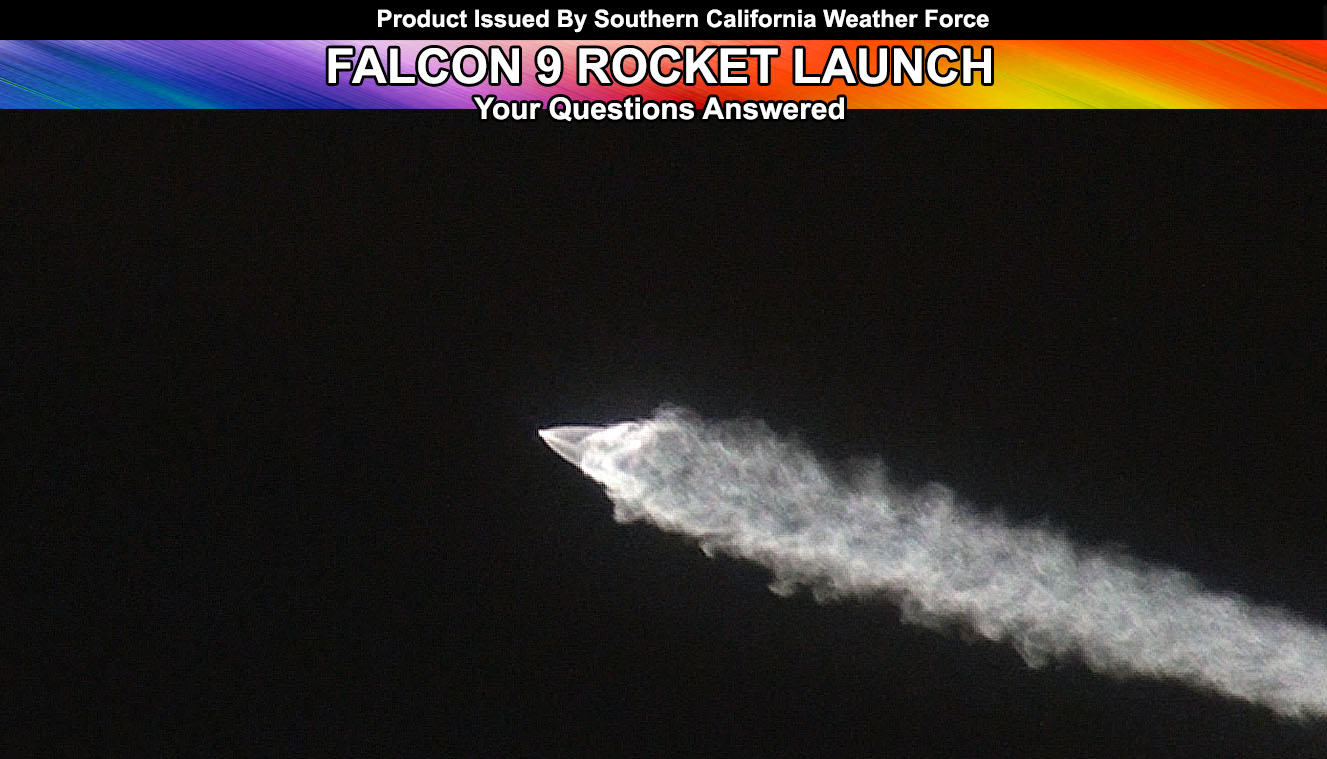Many across the Southern California area and as far as New Mexico saw the Falcon 9 Rocket Launch on Friday evening. This article will explain some questions I saw, I also take you into the future a bit to look at the coming weather pattern. Read on for details.
Just after 5:28pm on Friday December 22, 2017, Southern Californians looked up to see the flame of the Falcon 9 Rocket Launch Vehicle, launched by Vandenberg Air Force Base, owned by SpaceX, a private funded operation that launches their own rockets into orbit, even supplies to the International Space Station.
If it does not say “Liked” LIKE The Page Below and join thousands of informed weather forecast viewers in our region for more of the updates!
The exhaust trail started out thin at first and went from orange to bright white. This was because the sun had set 30 minutes before and while it was twilight down here, it was still sunny at an altitude of 30 miles high, which is the altitude the exhaust changed from orange to white. The better way to explain this is the mountains. Have you ever seen a sunset or sunrise where the top of the mountain is still showing sunlight, even an orange/pink color, while the bottom, including your area, has no Sun? This is, on small scale, what the rocket went through that evening. It started out with no sunlight at the launch pad, but launched up into where the upper atmosphere was still having sunlight.
When the rocket’s first stage was done with the boosting portion of the flight, the exhaust stopped… resuming again not too long after. This was the second stage firing. The object that appeared to be following the comet looking second stage was the booster stage. All the ripples you saw were the thrusters on various sides of it course correcting to land or fall where the SpaceX team wanted to bring it down in the ocean. The Falcon 9 Rocket usually lands on a barge in the ocean and the booster stage is capable of vectoring itself for such a landing.
HATE THE ADS or Love the Forecasts and Want To Support The Work To Help it Stay? Become a premium member and support the service and receive forecast perks as well …
Click Here To Learn More …
Other questions that were asked was why did it look like a giant sperm cell. What caused the rapid expansion? Well you have to understand that the upper atmosphere where this happened is extremely cold. The exhaust smoke would turn into ice particles up there. The expansion was caused by less gravity to hold the smoke column together. As the compact column went from more gravity in the low levels of the atmosphere to less gravity in the upper atmosphere, the column would go from thin to thick, and finally expanding. Best way I can further explain this would be pretending you where on the ground and taking two rocks and throwing them equally to the side of you. They would go out a bit and fall back to the ground. That would be how the exhaust of the rocket would act. Now imagine you were over 60 to 100 miles up with less gravity and you did the same thing, at the same speed. Because of less gravity these rocks would continue going away from you to the side with very little fall back to Earth. They would expand outward away from each other. This is the same cause for the expanding ice exhaust plume as the rocket went from more gravity to less gravity.
The plume came to a stop and all that was left was a comet looking second stage zooming into orbit. This is because there was no longer any moisture to form ice up there as the rocket left the Earth’s atmosphere and into low Earth orbit .. .so all that was visible was the comet like fan-shaped exhaust from the engine.
Other questions were why did the first falling part glow orange as it neared the horizon. This is simple, the stage fired the main stage again to slow down before hitting the ocean water as to not damage the booster.
Last question is why couldn’t it have been North Korea? Well because you’re still alive and also it was ascending, not descending … Also why do I have it at video at the Southern California Weather Force Facebook Page from start to finish?
Now onto the coming pattern. The coming pattern is pretty dry still but as stated before so was the 2005-2006 season, a season I am comparing this one to. Given what I’m seeing in the amplified riding pattern, we will have our next chance of a cold system coming in sometime between January 4th and January 8th. Since I am going for a 2005-2006 season, confidence in storms after our solstice is high and we gain strength well into March.
Stay tuned to Southern California Weather Force for any additional updates
Click Here To Find Your Zone On Facebook For Updates Now and In The Future

